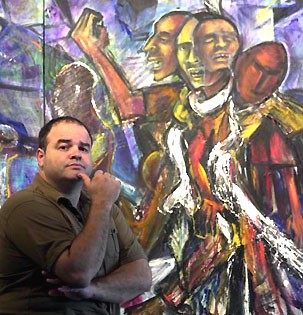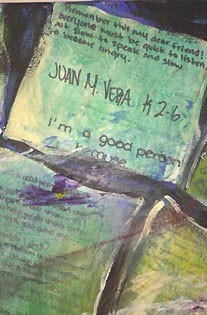South Florida Sun-Sentinel
February 6, 2002
By Maya Bell
Miami Bureau
The day a 17-year-old boy strangled himself in the Miami-Dade County Jail, Xavier Cortada left the sterile concrete lockup west of Miami’s airport, drove to his studio and, with tears streaming down his face, took his rage out on canvas.
With bold, brooding strokes, Cortada painted the boy’s body dangling from a bed sheet, swinging back and forth like a

Rage. Miami lawyer-artist Xavier Cortada painted his mural `convictim’ after a teenager committed suicide in jail.
PHOTOS BY SUSAN STOCKER/SOUTH FLORIDA SUN-SENTINEL
pendulum, the thrashing weight cutting an angry red gash into the floor.
To the Miami artist, lawyer and community activist, the floor might as well be the conscience of Florida, wounded by its policy of giving prosecutors the power to turn children who do bad things into adults with nothing more than the stroke of a pen.
When Cortada painted the image for a Miami-Dade Art in Public Places exhibition running through March 26, he did not know the dead boy’s name. Or that he was transferred to adult court after his first arrest on drug charges. Or even how he killed himself — that he was so determined to die, he knelt on the floor, made a noose with a sheet, tied it to his neck and a pipe under the sink, then pulled until all the life drained out of him.
But Cortada already was on a mission with the Miami-Dade Public Defender’s Office to enlist the 140 boys, confined to the second floor of the Turner Guilford Knight Correctional Facility, in a collaborative mural inspired by the state’s “direct file” law. The mural is part of the “ArtCARE: Outreach to Juveniles Being Tried As Adult” exhibit, which includes photographs of boys who participated by Tim O. Walker.
“We say we love our children, but it’s conditional love. We love them unless — unless they’re threatening, unless they’re poor, unless they need our help,” Cortada says. “The ‘direct file’ policy is proof of that. We do it so we have a clear conscience. So we can say, ‘Well, we don’t have to love you. You’re an adult.’”
Expanded after teen robbers killed a number of tourists in the early 1990s, the “direct file” law gives prosecutors discretion to charge juveniles as young as 14 in adult court without a hearing before a judge. The number of transfers has been plummeting since lawmakers beefed up the juvenile justice system in 1994, but Florida consistently leads the nation, and Miami-Dade leads the state, in the number of minors it christens adults.
Last year, 2,077 children under 18 were bound over to adult court, 415 of them in Miami-Dade. The overwhelming majority were not accused of murder, but of burglary, robbery and drug crimes.
Prosecutors defend the system, saying they use transfers to protect the public from kids who are either too old or too dangerous for the juvenile system. After all, they say, the juvenile court loses jurisdiction of youths at age 19.
Many criminologists, psychologists and juvenile judges have long argued that the “adult crime, adult time” mantra that guided Florida’s get-tough approach to spiraling juvenile crime in the early 1990s is doing more harm than good by giving up on kids.
Science backs them up.
Every study on the subject, including one sponsored by the U.S. Department of Justice for the state Legislature, shows that kids transferred to the more punitive adult system commit new crimes more violently and more quickly than similar youths punished in the more rehabilitation-oriented juvenile system.
Scott Bernstein, a Miami-Dade juvenile court judge, says the reasons are obvious.
“The only thing I can guarantee about every child I see is that, over time, they are going to change,” Bernstein said. “They are going to grow up. Now, who do you think will get the best results teaching them to be adults? A trained counselor who works on anger management, life skills, appropriate behavior? Or adult criminals in our jails?”
Cortada is pretty much alone in turning to art to spread that message. He began using art as an agent for social change in the slums of Soweto, South Africa, where he lectured on drug abuse for the U.S. Information Agency in 1994.
He became an expert on drug abuse and other anti-social behaviors in much the same way he became an artist — circuitously. After graduating from the University of Miami School of Law in 1991, he joined UM’s psychiatry department to lead prevention programs for juvenile violence and delinquency.
That’s where he picked up the “pro-social” message that propels him to paint murals about AIDs, poverty, racism and other

Who I am. Encouraged by Xavier Cortada, boys in a Miami-Dade jail wrote rap songs, poems and essays that the artist added to his mural.
PHOTO: Labeled. Artist Xavier Cortado asked teenagers sent to adult jail what they would like to see printed on the backs of their jail jumpsuits: `Don’t throw me away,’ one wrote. `I’ve got potential.’
SUSAN STOCKER/SOUTH FLORIDA SUN-SENTINEL
social ills. Working with sociologists, psychiatrists and doctors, he learned that kids who turn to crime and drugs usually lack positive bonds with families, schools and communities.
It wasn’t, though, until he stood in a community center in Soweto that he realized art could help build those bonds. The New York-born Cuban-American who grew up in Miami couldn’t quite connect to the bedraggled Zulu boys. So he loosened his tie, dispensed with his translator and fetched his sketchpad.
As if by magic, the barriers evaporated. The boys grew interested and animated. Cortada, now 37, was transformed.
“That process has translated into what I do now,” Cortada says. “I had always doodled and drawn but it wasn’t until then that I said, ‘Wait a minute. I am not a professor. I am not a lawyer. I am an artist.’”
It was his legal training, however, that propelled Cortada to turn his sights — and paintbrush — on Florida’s practice of treating some teens as adults in court.
When he walked into the jail for the first time late last year, he expected the kids there to be different from those he had worked with in juvenile programs. He thought they would be “scary, threatening, hard-core,” the very picture of the fearsome “super-predators” who had inspired the get-tough juvenile laws.
But he met were pimply-faced boys swimming in oversized jailhouse jumpsuits and adult-sized woes. Cortada thought of them as “convictims” — part convict, part victim.
Cortada spent very little time there doing the stuff most people think artists do. He didn’t paint or sketch. He gave pep talks, told stories, asked questions, listened, learned and encouraged.
The boys responded, writing rap songs, poems and essays. They jotted down what they would write on the back of their jumpsuits, eagerly pasting their words on the mural that will hang in the lobby of the public defender’s office. One of the jumpsuits hangs in the exhibit. “A person with feeling, not an animal,” one boy said. “Don’t throw me away. I’ve got potential,” another said.
Ranging in age from 14 to 18, each had a different story, but shared some similarities. Few knew both parents, or could count on them for guidance or support. Most lived in neighborhoods awash in poverty, violence and drugs. Until their arrests, some had never had three meals a day or the same bed each night. They rarely thought about consequences or the future.
But perhaps the most striking similarity was their resemblance to the boys of Soweto. With few exceptions, they were black. That’s not unique to Miami-Dade. Although blacks make up roughly 27 percent of the Florida juveniles arrested every year, they represent more than half of the transfers to adult court.
“I’m not saying these kids didn’t do wrong. I’m not saying they shouldn’t be locked up,” Cortada said, “but the truth is this place is full of kids without expensive lawyers, without the means, without the support systems, to get them out.”
Most had many chances in the juvenile justice system, but failed when they were returned to the same environment where they found trouble. One youngster with an engaging smile, a thick brow and a way with words was typical. The boy, who turned 18 in jail, has a drug abuse problem and rap sheet for breaking into houses and stealing other people’s valuables. His mom married when she was 13; his dad was too busy losing his battle with alcohol to work, leaving his son to be man of the house.
“Sometimes my dad doesn’t do what a man should do — you know, get a job and make money,” the boy said in his cell. “So I did what I could. I’d give my mom money, tell her it was from helping people move. She didn’t believe me, but she took it because we needed it.”
But Garry Petit-Frere never had a crack at the juvenile system, and in Cortada’s opinion, is the “ultimate convictim.” The 17-year-old Haitian boy whose last name means “little brother” in French was arrested for the first time last July for possession of cocaine and a shotgun. Because of his age and his charges, prosecutors bound him over to adult court. He quickly bonded out.
A few months later, Petit-Frere was re-arrested on another drug charge and, four days before Christmas, in the county jail. Less than 10 hours later, he was found kneeling in his cell, his head under the sink, a noose tightly knotted around his neck.
“Little brother,” Cortada said. “His name says everything. He’s our little brother and he died on our watch.”
Copyright © 2002, South Florida Sun-Sentinel